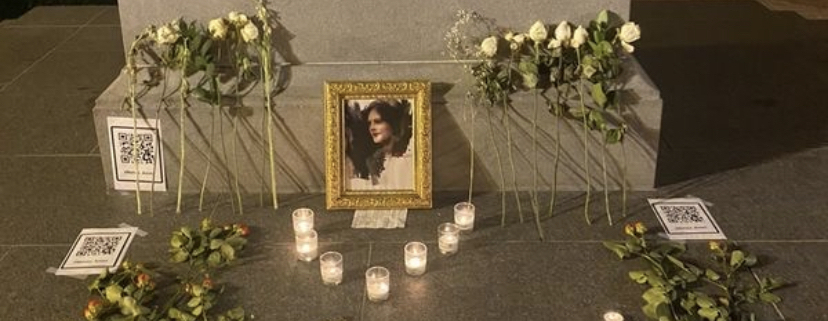Iranian students react to Mahsa Amini’s death
The USC Persian Academic and Cultural Student Association organized two vigil nights on campus on Sept. 21 and Sept. 23 in remembrance of Mahsa Amini, a 22-year-old Iranian woman who died in police custody.
Amini died on Sept. 16 in a Tehran hospital three days after the morality police arrested her for violating Iran’s hijab law. Since Sept. 23, her death has sparked large-scale protests across the nation in at least 40 cities demanding an end to the conservative dress and hijab law.
According to NPR News, police arrested Amini, who was originally from Kurdistan province, in her brother’s car during a visit to Tehran to see family members, sent her to a detention center to receive training on hijab laws before transferring her to a hospital where she passed away due to a heart attack — based on the Iran authority’s claim.
However, Amini’s family disputed the assertion and stated with the support of eyewitnesses that the police beat Amini after they arrested her. Reports reveal that Amini’s death was caused by a fracture in her skull due to heavy blows to her head, according to the Associated Press.
Maideh Masiha Orangi, a junior majoring in philosophy, politics and law heard the news of Amini’s death after returning from a religious trip to Iraq.
“It was really odd, unsettling to see that same religion I felt so close to misportrayed and misused in the enforcement of hijab as well as resulting in the death of someone,” Orangi said.
Ever since the establishment of the Islamic Republic in Iran as a result of the 1979 Iranian Revolution, Iran’s “hijab and chastity” law requires all women and girls over the age of nine to wear a headscarf in public.
“I think it’s not fair for you to be able to say someone is misportraying or miswearing the hijab when they themselves did not choose to do so … I think women should have the choice to wear hijab and also to preserve the sacredness of hijab because when it’s being forced, the value of it, the importance of it goes down,” Orangi said.
Negar, another Iranian student who is not comfortable disclosing her full name, worries of political retaliation from the Iranian government. She said she felt “shocked, angry and terrified” after hearing the news.
“I put myself in Mahsa’s shoes and all the people who are currently being killed in Iran and I believe that this could have happened to any one of us, not just Mahsa,” Negar said.
USC students showed their sympathy by bringing flowers, which according to PACSA symbolize Amini’s life and memory, as tributes to the vigils. Orangi attended both of them and valued the opportunity to connect with other students.
“A lot of us feel this guilt that we are seeing what’s happened to our country, to people online, but we have the privilege of being in the United States and not experiencing that,” Orangi said. “I think us being able to have these vigils in these communities is really important and a lot of us tend to connect with others … I guess [to] dispel some of the guilt we feel by not being able to directly help our country as much.”
Negar also called for support from non-Iranian students at USC.
“The main purpose of [vigil nights] is that they want more support from non-Iranians and they want other students to stay in solidarity with us, [to] inform others about the current situation in Iran,” Negar said.
Protest against Iran’s religious dictatorship in response to Amini’s death still continues. Since Oct. 2, at least 133 protesters, including children, have been killed, according to Iran Human Rights, a non-profit human rights organization in Norway.
Internet services in Tehran and other parts of the country were confirmed by NetBlocks, a watchdog organization that monitors governance of the Internet, to be partially restricted on Sept. 16 when the protest first broke out. Instagram and WhatsApp were restricted nationwide as well on Sept. 21, followed by massive shutdowns of national mobile networks.
“In the past five years or so, I would say protest, while starting with reasons, very quickly take on a broader anti-government tone, and this was no exception,” said Ciruce Movahedi-Lankarani, a professor of Middle East Studies at the Dornsife College of Letters, Arts and Sciences. “What is different this time is the way that women have been at the forefront of the movement.”
Movahedi-Lankarani also recognized that shutting down the internet is one way that the Iran authorities use to prevent international intervention.
“The power structure of the government, to a very great degree I think, doesn’t care about what human rights organizations say. So one of the tools that people use is to shut down the internet,” Movahedi-Lankarani said.
Although nationwide protests continue, Movahedi-Lankarani reasoned that it would not bring a significant change to Iran’s political system.
“In essence, I don’t think we are likely to see a wholesale change … more likely is that we might see a kind of quiet retreat from a setup enforcement of the kind of cultural, social, laws or issues,” Movahedi-Lankarani said.



